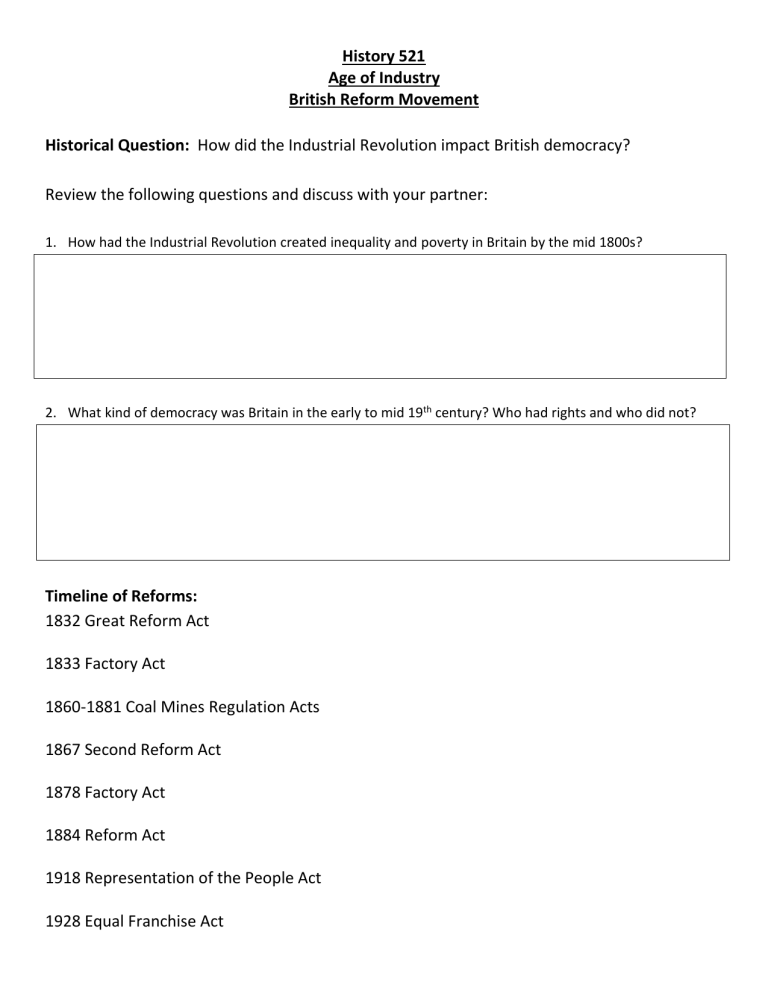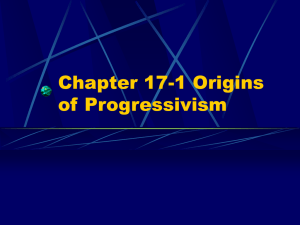1860-1881 Coal Mines Regulation Acts

History 521
Age of Industry
British Reform Movement
Historical Question: How did the Industrial Revolution impact British democracy?
Review the following questions and discuss with your partner:
1.
How had the Industrial Revolution created inequality and poverty in Britain by the mid 1800s?
2.
What kind of democracy was Britain in the early to mid 19 th century? Who had rights and who did not?
Timeline of Reforms:
1832 Great Reform Act
1833 Factory Act
1860-1881 Coal Mines Regulation Acts
1867 Second Reform Act
1878 Factory Act
1884 Reform Act
1918 Representation of the People Act
1928 Equal Franchise Act
Read the descriptions of each reform act and then fill out the corresponding chart. Also, respond to the questions that follow.
1832 Great Reform Act
In 1832, Parliament passed a law changing the British electoral system. It was known as the Great Reform Act.
This was a response to many years of people criticizing the electoral system as unfair. For example, there were constituencies with only a handful of voters that elected two Members of Parliament (MPs) to Parliament. In these rotten boroughs (districts), with few voters and no secret ballot, it was easy for candidates to buy votes.
Yet towns like Manchester that had grown during the previous 80 years had no MPs to represent them.
Rotten boroughs were removed and the new towns given the right to elect MPs, although constituencies were still of uneven size. However, only men who owned property worth at least £10 could vote, which cut out most of the working classes, and only men who could afford to pay to stand for election could be MPs. This reform did not go far enough to silence all protest.
1833 Factory Act
'Ten-Hour Movement'
Even mill-owners were beginning to speak up for improved conditions. A strong humanitarian campaign had grown outside Parliament, championed by the MPs Anthony Ashley-Cooper (later the 7th Earl of Shaftesbury) and Michael Sadler, and by manufacturers in the textile areas of Lancashire and Yorkshire. Ashley-Cooper led the 'Ten-Hour Movement' aiming to reduce the working day for children under 16. Another Factory Act was passed in 1831, limiting the working day to 12 hours for all those under 18. Yet again, there were no procedures for enforcement.
Further parliamentary inquiry and a Royal Commission produced reports full of details of the appalling abuse and mistreatment of children in factories. In 1833 Parliament passed a new Factory Act. Previous Acts had been restricted to the cotton industry, but the 1833 Act also applied to the older woollen producing communities in and around Yorkshire which had been ignored in previous legislation.
No children were to work in factories under the age of nine (though by this stage numbers were few). A maximum working week of 48 hours was set for those aged 9 to 13, limited to eight hours a day; and for children between 13 and 18 it was limited to 12 hours daily. The Act also required children under 13 to receive elementary schooling for two hours each day.
Factory Inspectors
What made the 1833 Act so important was that it established a system to ensure that regulations were enforced. A small, four-man 'inspectorate of factories' was created, responsible to the Home Office, with powers to impose penalties for infringements. In its early days the inspectorate was far too small to enforce the Act in 4,000 mills, and so the Act was widely evaded. It did, however, create the beginnings of a muchneeded system of government control.
1878 Factory Act
The 1878 Factory Act added the following provisions:
No child anywhere under the age of 10 was to be employed.
Compulsory education for children up to 10 years old.
10-14 year olds could only be employed for half days.
Women were to work no more than 56 hours per week.
Coal Mines Regulation Acts, 1860-1881
In parallel with factories, mills and workshops, Victorian legislators also responded to concern about working conditions in coal mines, especially the employment of women and children.
In 1842 a Report by a Royal Commission on the employment of women and children in mines caused widespread public dismay at the depths of human degradation that were revealed. Owners showed a critical lack of concern or responsibility for the welfare of their workers. It was common for children aged eight to be employed, but they were often younger. In mines in the east of Scotland girls as well as boys were put to work. In order to reinforce its message to MPs, the Commissioners' Report was graphically illustrated with images of women and children at their work.
Reform of the Mines
The Mines and Collieries Bill, which was supported by Anthony Ashley-Cooper, was hastily passed by
Parliament in 1842. The Act prohibited all underground work for women and girls, and for boys under 10.
Further legislation in 1850 addressed the frequency of accidents in mines. The Coal Mines Inspection Act introduced the appointment of inspectors of coal mines, setting out their powers and duties, and placed them under the supervision of the Home Office. The Coal Mines Regulation Act of 1860 improved safety rules and raised the age limit for boys from 10 to 12.
By 1870 over 1,000 lives were still being lost in mining accidents each year. In 1872 the Coal Mines Regulation
Act introduced the requirement for pit managers to have state certification of their training. Miners were also given the right to appoint inspectors from among themselves. The Mines Regulation Act, passed in 1881, empowered the Home Secretary to hold inquiries into the causes of mine accidents. It remained clear, however, that there were many aspects of mining that required further intervention and regulation.
1867 Reform Act
The 1867 Reform Act enfranchised (gave the right to vote) 1,500,000 men. All male urban householders and male lodgers paying £10 rent a year for unfurnished accommodation got the right to vote. The act all but doubled the electorate. 52 seats were redistributed from small towns (less than a population of 10,000 such as
Chichester, Harwich and Windsor) to the growing industrial towns or counties. Birmingham, Leeds, Liverpool and Manchester saw their representation increase from 2 MP’s to 3 MP’s. The University of London was also given a seat. The counties of Cheshire, Kent, Norfolk, Somerset, Staffordshire and Surrey were all given 6 MP’s instead of 4. In 1868, Scotland was given seven new MP’s as some new constituencies (voting districts) were created or existing constituencies were expanded. The representation in Ireland remained the same.
1884 Reform Act
The 1884 Reform Act, (strictly the Representation of the People Act 1884 though it was also known as the
Third Reform Act), was the third reform to Britain’s system of voting in the Nineteenth Century. The 1867
Reform Act had been so extensive that there seemed to be little to change. However, while the 1867 Reform
Act had concentrated on urban areas, the 1884 Reform Act was to target rural areas that had been bypassed by the 1867 act.
The electorate after this act stood at 5,500,000 – though an estimated 40% of all men still did not have the right to vote as a result of their status within society. However, the 1884 Reform Act along with the 1832 and
1867 acts did nothing for women - none of whom had the right to vote regardless of their wealth.
1918 Representation of the People Act
This British Parliament passed the 1918 Representation of the People Act with an overwhelming majority.
The 1918 Representation of the People Act gave all men over the age of 21 the right to vote (and aged 19 if the men had been on active service in the armed forces). It also enfranchised women over the age of 30 who owned property. Therefore, politically women were still not the equal to men in Britain even after the 1918 act.
Women are given the right to vote 1928
During 1916-1917, the House of Commons Speaker, James William Lowther, chaired a conference on electoral reform which recommended limited women's suffrage.
Influential consideration
An influential consideration, in addition to the suffrage movement and the growth of the Labour Party, was the fact that only men who had been resident in the country for 12 months prior to a general election were entitled to vote.
This effectively disenfranchised a large number of troops who had been serving overseas in the war. With a general election imminent, politicians were persuaded to extend the vote to women at long last.
Representation of the People Act 1918
In 1918 the Representation of the People Act was passed which allowed women over the age of 30 who met a property qualification to vote. Although 8.5 million women met this criteria, it only represented 40 per cent of the total population of women in the UK.
The same act extended the vote to all men over the age of 21. The electorate increased from eight to 21 million but there was still huge inequality between women and men.
Equal Franchise Act 1928
It was not until the Equal Franchise Act of 1928 that women over 21 were able to vote and women finally achieved the same voting rights as men. This act increased the number of women eligible to vote to 15 million.
Reform
1832 Great Reform Act
1833 Factory Act
1860-1881 Coal Mines
Regulation Acts
1867 Second Reform Act
1878 Factory Act
19 th and early 20 th century British Social and Political Reforms Chart
Key Features How it improved British society
How the reform fell short or was limited
1884 Reform Act
1918 Representation of the People Act
1928 Equal Franchise Act
Examine the table below
Discuss the following question with your partner:
To what extent had the 1833 and 1878 Factory improved the conditions of Child Labor in Britain?
Improved Not improved
Write an introduction and thesis statement for the following question:
How did the Industrial Revolution impact British democracy?
_____________________________________________________________________________
_____________________________________________________________________________
_____________________________________________________________________________
_____________________________________________________________________________
_____________________________________________________________________________
_____________________________________________________________________________
_____________________________________________________________________________
_____________________________________________________________________________
_____________________________________________________________________________
_____________________________________________________________________________
_____________________________________________________________________________
_____________________________________________________________________________
_____________________________________________________________________________
_____________________________________________________________________________




